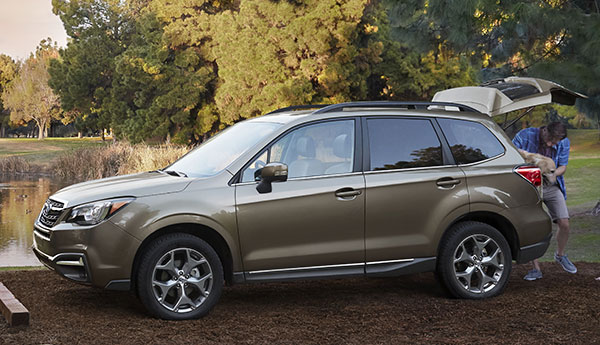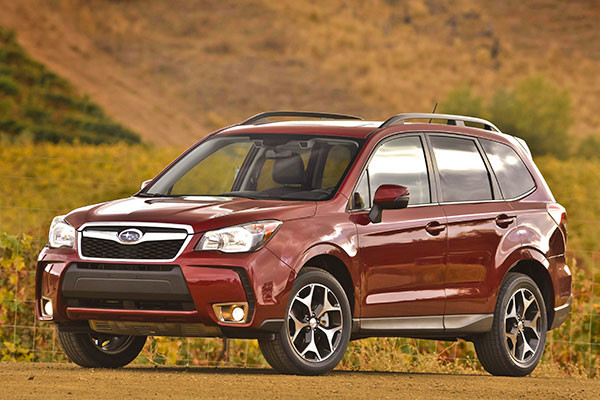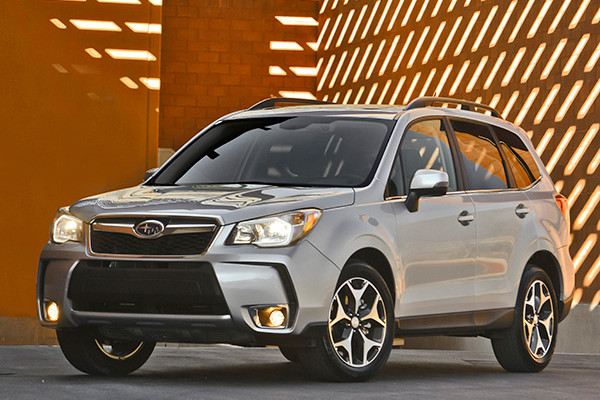

an account. You can:
Access your saved cars on any device.
Receive Price Alert emails when price changes,
new offers become available or a vehicle is sold.


Model Overview of The Subaru Forester's For Sale in Middletown, CT
2017 Subaru Forester Information
2017 Subaru Forester
The Subaru Forester is well known by now, as a compact, wagon-like utility vehicle. With the ride and handling of a car, it was basically a crossover before crossovers were invented, bringing superb all-weather security with all-wheel drive, and primitive road capability with nearly nine inches of ground clearance. Forester is the best-selling Subaru, and in 2014 it won The Car Connections Best Car To Buy award.
We recently spent six months with a turbocharged Forester 2.0XT, testing it in a variety of conditions and terrains, confirming our belief its an excellent car to buy. The CVT works very well, and delivers fuel mileage as high as 28 miles per gallon. Forester doesnt have the agility of the Ford Escape or Mazda CX-5, but from the drivers seat it feels far sportier than the Honda CR-V, Nissan Rogue, or Toyota RAV4.
The 2017 Forester gets updated styling, with a mesh grille, tweaked front bumper on Forester 2.5i models, and a C-shape for the headlamps and taillamps. One thing that remains is superb visibility through the upright glass.
Base engine is a 2.5-liter, horizontally opposed four-cylinder engine making 170 horsepower. This boxer engine is mated to a 6-speed manual gearbox or continuously variable transmission (CVT). Acceleration is adequate.
A quicker option is the turbocharged 2.0-liter that makes 250 horsepower and 258 pound-feet of torque; it comes only with a paddle-shifting CVT, which can be programmed to feel like a six-speed or eight-speed automatic transmission using Subarus SI-Drive system.
The 2017 Subaru Forester 2.5i CVT delivers EPA-rated fuel mileage of 26/32 mpg City/Highway, or 28 mpg Combined; the 6-speed manual transmission is rated only 25 mpg Combined. The 2017 Forester gets an increase of one mpg over the 2016 model, thanks to sharpened engine management.
The 2.0XT model, with the 2.0-liter turbocharged engine, which requires Premium fuel, is rated at 23/27/25 mpg City/Highway/Combined. Over a few thousand miles during our six-month test with a 2.0XT, we averaged 24.1 miles per gallon.
The federal NHTSA gives the Forester five stars overall for crash safety, and the insurance industrys IIHS confirms the praise with top ratings in every crash test including the challenging small overlap frontal crash, to Top Safety Pick Plus.
The 2017 Forester makes available some new active safety features: The EyeSight camera system, which spots dangers on the road ahead and self-brakes, gets a longer and broader field of vision. The 2017 Forester offers reverse automatic braking, and the automatic headlamps now turn with the car. 2017 Forester Limited and Touring models have blind-spot monitors and rear cross-traffic alerts.
2016 Subaru Forester Information
2016 Subaru Forester
The Subaru Forester is a well-known compact crossover utility vehicle with all-wheel drive. It is Subarus bestselling model. The Forester looks and feels more like a wagon than an SUV; in fact, the Forester pretty much invented the crossover. It adds practicality and versatility to its rugged all-weather capability. It can carry five people and their bags, if not all their back-country gear. Theres a roof rack for that. It will even tow a small trailer.
Competitors include the Mazda MX-5, Ford Escape, Honda CR-V, Nissan Rogue, and Toyota RAV4; but, ironically, its main competition might be the Subaru Impreza XV Crosstrek.
The base Forester 2.5i is powered by a 170-horsepower, 2.5-liter H4 (horizontally opposed cylinders, also called a boxer engine). The faster Forester 2.0XT is powered by a 2.0-liter boxer, turbocharged direct-injection, making 250 horsepower and 258 pound-feet of torque.
Forester 2.5i is one of the few compact crossovers that you can get with a 6-speed manual transmission, but most opt for the CVT. Forester 2.0XT only comes with a CVT.
For 2016, Forester gets few changes: some additions to security and infotainment, enhancements to the system Subaru calls Starlink. This generation of the Forester was completely redesigned for the 2014 model year.
Forester is an IIHS Top Safety Pick+. In the NHTSA crash tests it got five stars in every category but frontal impact, where it got four. Its EPA fuel mileage of 24/32/27 mpg City/Highway/Combined is at the top of the compact crossover class.
2014 Subaru Forester Information
2014 Subaru Forester
The Subaru Forester all-wheel drive compact crossover is completely redesigned for 2014. This fourth-generation 2014 Forester is slightly larger in all dimensions than the outgoing model (2009-2013). It wears somewhat bolder skin wrapped around a roomier cabin and boasts both improved performance and higher fuel economy.
A 170-horsepower 2.5-liter horizontally opposed flat four-cylinder (aka boxer or H4) is standard on the 2014 Forester, while a new 250-hp turbocharged version of the BRZ sports car's 2.0-liter H4 powers 2014 Forester 2.0XT models. It uses a combination of direct fuel injection, high compression (10.6:1), Subaru's Dual Active Valve Control System (D-AVCS) and intercooled turbocharging to deliver a much more spirited 250 horsepower and 258 pound-feet of torque between 2000 and 4800 rpm.
All 2014 Forester models come with Subaru Symmetrical All-Wheel Drive. Subaru is a leader in all-wheel-drive technology and this sets Forester apart from front-wheel-drive competitors that offer all-wheel drive as an option. A 6-speed manual gearbox supersedes the previous 5-speed manual as standard, while Subaru's Lineartronic continuously variable transmission (CVT) replaces the old 4-speed automatic.
The CVT mated to the 2.5-liter engine has a selectable low shift mode that adds engine braking on downhill grades. The high-torque version of this transmission comes with the turbo engine and has steering wheel paddles for manual shifting. Both use adaptive control to continually optimize gear ratios based on driving preferences and conditions.
The 2.5-liter four-cylinder together with the CVT, likely the best-selling combination, boasts the segment's best all-wheel drive fuel economy at an EPA-estimated 24/32 mpg City/Highway, or 27 Combined. That highway rating is a five-mpg improvement over the most fuel-efficient 2013 Forester.
Compared to the previous-generation model, this new 2014 Forester feels more agile thanks to a 50-percent stiffer structure, retuned front strut and double-wishbone rear suspensions and larger, 17-inch tires and wheels. The upgraded rear suspension uses pillow ball joint mounts for its lateral links to smooth the ride. We found the four-wheel independent suspension delivers fairly agile handling with good ride. The new Electric Power Assisted Steering gives surprisingly good feel and feedback while contributing to improved fuel efficiency.
The much quicker, more athletic and more fun to drive 2014 Forester 2.0XT turbo models boast a sport-tuned suspension on 18-inch wheels and larger brakes with ventilated rotors front and rear.
Technology abounds on the 2014 Forester: A new rearview camera along with a new color multi-function display are available. Subaru's available new EyeSight driver assist system uses a stereo camera (instead of radar) to integrate Adaptive Cruise Control, Pre-Collision Braking and Vehicle Lane Departure Warning.
A Subaru Intelligent Drive (SI-DRIVE) feature on 2.0XT models has a steering-wheel switch that lets you choose from among three driving modes: Intelligent (relaxed throttle response for normal driving), Sport (quicker throttle response and a 6-speed-manual mode for the CVT), or Sport Sharp. The latter delivers even quicker response with eight manually selectable ratios.
All Foresters come with Symmetrical All-Wheel Drive. CVT models use a more sophisticated electronically managed type than do those with the 6-speed manual. Both systems continuously power all four wheels, transfer torque to those with the best grip and integrate with the Vehicle Dynamics Control (VDC) system to improve all-weather traction and stability.
A new X-Mode feature on upgrade models optimizes control of the engine, transmission, Active AWD, brakes, VDC and other systems to further improve control on slippery surfaces and steep inclines, while Hill Descent Control uses the VDC system to maintain constant speed and improve control on downhill grades.
We are impressed with the 2014 Forester's improved dry-surface dynamics (ride, handling, steering, braking) and its noticeably roomier, quieter, more comfortable cabin. The Forester 2.0XT's tighter suspension and more aggressive tires elevate this five-passenger compact CUV almost to the level of sport-sedan fun.
Acceleration performance with the standard engine is slow (capable of 0-60 mph in a long 9.3 seconds), but the 2.0XT's powerful turbo engine improves that measure to a quick 6.2 seconds. Earlier Subaru boxer engines were rough, but they have become far smoother and more refined in recent years.
The 2014 Subaru Forester boasts several advantages over its most popular competitors among the compact crossover utility vehicles. Most important are Forester's standard all-wheel drive at a lower price than Toyota's RAV4, Honda's CR-V, and Mazda's CX-5 with optional all-wheel drive. Forester also boasts a roomier cabin front and rear and surprisingly better EPA fuel economy with the available CVT vs. the competition when equipped with automatic transmissions and all-wheel drive.



